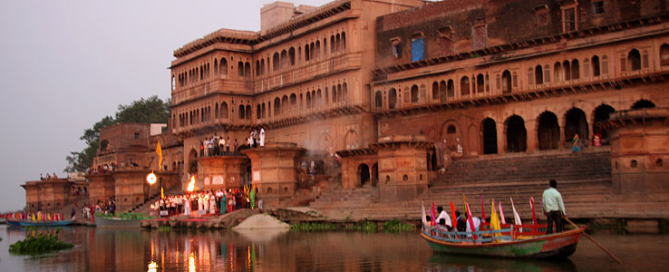A lo largo de mi viaje conocí las creencias de las tribus africanas, me relacioné con católicos protestantes, con evangelistas, conocí espiritistas y hasta un curandero que era aclamado por la fe de miles de personas. En medio oriente me interioricé por el Islam y también por el judaísmo; y cuando llegué a la India conocí el Sikhismo, el Hinduismo y el Budismo.
Pero cuando con Clara llegamos a Matura y pedaleamos a Vrindavan entendí que nos encontrábamos en uno de los lugares más sagrados de toda la India y del mundo entero, porque se cree que éste fue el lugar dónde 5000 años atrás nació y vivió Krishna.
Para las principales tradiciones hindúes Krishna es una de las principales encarnaciones de Vishnu, (el Dios de la preservación y alimentación del mundo) pero para el vaisnavismo (devotos de Krishna) Krishna es la fuente de toda la realidad material así como de las encarnaciones divinas, y por lo tanto es visto como la “Suprema Personalidad de Dios”.
Conocí al Movimiento Hare Krishna en el año 99, cuando inicié mi viaje de bicicleta en Brasil. Fue en aquel entonces que cansado de mi rutina diaria quise descubrir otras filosofías de vida y por ello me interesé en los monjes Hare Krishna, cuando un amigo me aconsejó ir a conocerlos. Vivían en una comunidad en las afuera de Caruarú en el estado de Pernambuco, en lo alto de una sierra, a unos 800 mt de altitud, casi aislados. Allí pasé más de una semana, donde me acogieron de una manera muy cálida, y aunque bajo un régimen demasiado austero me invitaron a sus programas diarios transmitiéndome sus enseñanzas. Y por ello cuando dejé el lugar no era más el mismo. A mi partida de la comunidad, que casualmente era el inicio de mi vuelta al mundo en bicicleta, los monjes me regalaron un Bhagavad Gita que llevo conmigo hasta el día de hoy y también una yapa Hare Krishna, que es tipo un rosario, para que cante el mantra. Según ellos para que proteja mi alma. Con los años, el mantra se hizo parte de mi pedaleo, y el Bhagavad Gita mi libro de cabecera. Por ello estar en India y llegar a la tierra de Krishna tenía un valor agregado para mí.
La Sociedad Internacional para la Conciencia de Krishna (ISKCON), tiene como fin principal promover el bienestar de la sociedad humana enseñando la ciencia de la conciencia de Dios (la conciencia de Krishna) de acuerdo con las Escrituras védicas de la India, especialmente el Bhagavad Gita.

El Bhagavad Gita es la esencia del conocimiento védico y uno de los mayores clásicos de filosofía y espiritualidad del mundo. Se presenta en forma de un diálogo entre Krishna y Arjuna en pleno campo de batalla. Arjuna representa el papel de un alma confusa sobre su deber y recibe iluminación directamente de Krishna que lo instruye en la ciencia de la auto-realización. El Bhagavad Gita es un libro dirigido a las almas condicionadas que no tienen conocimiento de la vida espiritual.
Según las enseñanzas de Su Divina Gracia A.C. Bhaktivedanta Swami Prabhupada, (el fundador del Movimiento Hare Krishna en occidente), todos los seres humanos en el mundo material estamos afligidos, en cierta manera por algún tipo de tormento. La causa es el deseo de gratificar los sentidos y por ello debemos transmigrar de un cuerpo a otro, lo que se conoce como reencarnación.
La primera lección en la sabiduría védica es que no somos cuerpo, sino alma espiritual, partículas del Espíritu Supremo, pero debido a que nos olvidamos nuestra verdadera identidad nos identificamos con el cuerpo. Por ello nuestro cuerpo actual es el resultado de una larga serie de acciones y reacciones experimentadas en esta y otras vidas previas. Esta ley de la naturaleza es conocida en sánscrito como ley del karma, en palabras simples: cada acción tiene una reacción. El que actúa de manera justa recibe buenos resultados en la vida siguiente, y el que actúa de un modo negativo tiene que experimentar reacciones adversas en esta misma vida o en un próximo nacimiento.
El Bhagavad Gita también expone los diferentes tipos de yoga y meditación para librarse de la ley del karma y obtener conocimiento trascendental, y explica los tres modos de la naturaleza material y la perfección de la renuncia.
El Gita ha influido desde siempre a los pensadores de la India, como Mahatma Gandhi que decía: “Cuando las dudas se apoderan de mí, cuando me enfrento visiblemente con decepciones y no me resta ninguna esperanza, recurro al Bhagavad Gita y encuentro un verso que me conforta. Entonces empiezo a sonreír en medio de abrumadoras tristezas. Aquellos cuya meditación se inspiran en el Gita sentirán una alegría que se renueva a cada instante y descubrirán nuevos significados a cada lectura”.
Nuestra experiencia en Vrindavan fue más que fuerte; dicen que es un lugar sacrosanto y que tira afuera todo lo malo y lo bueno de uno, como ningún otro lugar. Quizás por ello Vrindavan no nos resultó un lugar cualquiera; porque nos puso a prueba, porque debido a la difícil cotidianeidad de la India y a la convivencia de 24 sobre 24 estábamos desgastados; pero supimos reaccionar y aunque en el final no lo creíamos dejamos la ciudad como de costumbre, juntos y agarrados de la mano más que nunca; y aunque por unos días sin las bicicletas.
Como dos turistas
Agotados de las bicicletas y de las dificultades que implican viajar con ellas en un país donde todo es precario, sucio y superpoblado decidimos dejar las bicis en Vrindavan y aventurarnos las últimas tres semanas de nuestra estadía para conocer los puntos de mayor interés que nos restaban, y por ello lo hicimos con una mochila, como dos simple turistas, o como diría Clara como gente normal.
La primera ciudad fue Agra, donde visitamos el Taj Mahal, el templo que fue construido por un emperador Mongol en el siglo XVII para conmemorar a su segunda mujer que falleció al dar a luz a su décimo cuarto hijo. En la actualidad la construcción que duró 20 años es el monumento mas visitado en toda la India. En principio, cuando llegamos a la ciudad y lo vimos de afuera no me pareció gran cosa, pero una vez que entramos realmente me resultó asombroso.
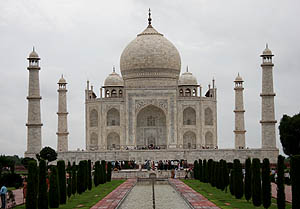
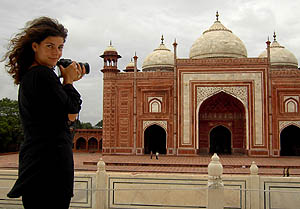
Luego nos fuimos a Jaipur, la capital del estado del Rajastán que según nos dijeron algunos viajeros es la parte más bonita de la India, por su desierto “fabuloso”. El viaje demoró 6 horas para recorrer los 200 km que la separan, pese a que este trecho es autopista. Todavía me cuesta creerlo! Jaipur es una ciudad de 3 millones de hab., pero que no parece de la India, porque es mucho mas civilizada y limpia, su gente es tranquila, no tocan bocina y no acosan al turista para venderle cualquier cosa. Son unos verdaderos señores. Allí vistamos el fuerte Amber y la ciudad vieja que se destaca por su gran bazar con todos sus negocios pintados de rosa. Y seguimos viaje.
Cuando llegamos a Udaipur comencé a extrañar la bicicleta y a preguntarme por que visitábamos aquellos lugares que son invadidos por los turistas y relatados por las guías como un lugar de fábulas, cuando en realidad no tienen nada. Y Udaipur es uno de ellos, porque no tiene nada, excepto un palacio y un lago, que en su centro tiene un hotel pintoresco y carísimo que ni siquiera se puede visitar. Y por ello nos fuimos al otro día, como dos verdaderos turistas, como aquellos que pasan más tiempo subidos a un autobús que recorriendo un lugar, sintiéndonos un poco tontos.
Pero finalmente tras 15 horas de viaje llegamos a Jaisalmer donde todo prometía cambiar. La ciudad vieja es la parte más interesante, está cercada por un muro y alberga un palacio, algunos templos y pequeños hoteles. El fuerte es un laberinto de estrechas calles situado en lo alto de una colina a 80 mt de altitud y por ello con vista única del lugar. Desde allí contratamos un camel safari, una excursión de dos días y una noche para recorrer el desierto, que en el fondo no es tan desierto. El único lugar bueno fue la duna gigante donde acampamos para pasar la noche. Claramente que tras haber recorrido los desierto de Danakil en Djibouti, el Sahara en Túnez y el de Wadi Rum en Jordania, éste nos pareció apenas un lugar para llevar turistas.
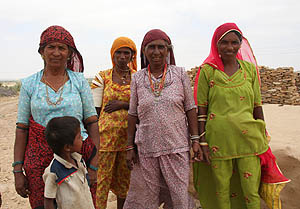
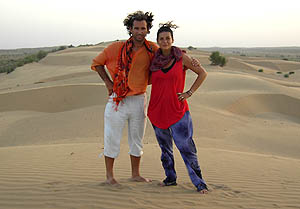
Luego viajamos a Delhi donde recibimos la visita de mi hermano que mezclaba sus vacaciones con negocios, por ello juntos recorrimos todos los mercados de la ciudad, otra vez. Allí festejamos el cumpleaños de Clara y también presenciamos el ramadán en la imponente mezquita de Jama Masjid, que como siempre es un espectáculo único y conmovedor. Luego volvimos a Vrindavan, prendimos las bicis y nos fuimos a pasar los últimos días de nuestra estadía a Varanasi.
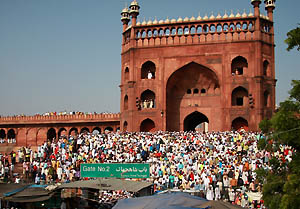
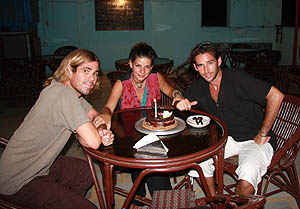
Vrindavan, the most sacred place
Along my trip I learned about the beliefs of African tribes, I met Protestant Catholics and evangelists, I heard about spiritualism and even I met a faith healer who was acclaimed by the conviction of thousands of people. In Middle East I learned about the Islam and the Judaism too; and when I arrived in India I knew the Sikhism, the Hinduism and the Buddhism.
But when Clara and I arrived to Matura and we cycled to Vrindavan I understood that we were in one of the most sacred places in the whole India and the world too, because it is believed that 5000 years ago this place was where Krishna was born.
For the main Hindu traditions Krishna is one of the main incarnations of Vishnu, (the God of the preservation of the world) but for the Vaisnavism (devotes of Krishna) Krishna is the source of all material reality as well as of the divine incarnations, and therefore He is seen as the “Supreme Personality of Godhead”.
I knew the Hare Krishna Movement in 1999, when I began my bicycle trip in Brazil. It was at that time that tired of my daily routine I wanted to discover other philosophies of life, thereby I was interested in the Hare Krishna monks, after a good friend advised me to go to visit them. They lived in a community 20 km from Caruaru city, in Pernambuco state, on the top of a mountain 800 mt high, almost isolated. There I stayed more than one week, where they received me in a very warm way, and although under a regime of austerity they invited me to their daily programs transmitting me their teachings. Therefore when I left the place, I was never the same again. To my departure of the community that by chance was the beginning of my trip around to the world by bicycle the monks presented me a Bhagavad Gita which I carry until today with me and a Hare Krishna rosary, according to them, so that they protect me and illuminate me. Thereby to be in India and to arrive to Krishna’s place had added value for me.
The International Society for Krishna Consciousness (ISKCON) has as main aim to promote the well-being of the human society teaching the science of the conscience of God (the conscience of Krishna) in accordance with the Vedic Scripture of India, especially the Bhagavad Gita.

The Bhagavad Gita is the essence of the Vedic knowledge and one of the biggest philosophy and spirituality classics of the world. It is presented in form of a dialogue between Krishna and Arjuna in the middle of battlefield. Arjuna represents the part of a confused soul on his duty and he receives illumination directly from Krishna who instructs him in the Science of the Self Realization. The Bhagavad Gita is a book directed to the conditioned souls which don’t have knowledge of the spiritual life.
According to the teachings of His Divine Grace A.C. Bhaktivedanta Swami Prabhupada, (the founder of the Hare Krishna Movement in the western countries), all the human beings in the material world are distressed, in certain way for some type of torment. The cause is the desire to gratify the senses and thereby we have to transmigrate from one body to other, what is known as reincarnation.
The first lesson in the Vedic wisdom is that we are not body, but spiritual soul, particles of the Supreme Spirit, but because we forget our true identity we identify ourselves with the body. Thereby our current body is the result of a long series of actions and reactions experienced in this and other previous lives. This law of nature is known in Sanskrit as law of karma, in simple words: each action has a reaction. The one who acts in a fair way receives good results in the following life, and the one who acts in a negative way has to experience adverse reactions in this same life or in a next birth.
The Bhagavad Gita also exposes the different kinds of yoga and meditation to get rid of the law of karma and to obtain transcendental knowledge, and It explains the three modes of material nature and the perfection of renunciation.
The Gita has always influenced to the thinkers of India, as Mahatma Gandhi who said: “When doubts take possession of me, when I face visibly with deceptions and I don’t have any hope left, I resort to the Bhagavad Gita and encounter a verse which comfort me. Then I begin to smile amid overwhelming sadness. Those whose meditation is inspired by the Gita will feel a happiness that is renewed to each instant and they will discover new meanings to each reading”.
Our experience in Vrindavan was strong; people use to say that it is a sacrosanct place and that it takes the entire bad and good thing out of oneself, as any other place. Perhaps thereby we didn’t find Vrindavan as a common place; because it put us on approval; because, due to the difficult daily routine of India and to the life together 24 hours a day our relationship was growing stale but we knew how to react and although at the end we didn’t believe it we left the city as usual, together and hand in hand, but this time more than ever; and although for some days without the bicycles.
As two tourists
Tired of the bicycles and of the difficulties that imply to travel with them in a country where everything is precarious, dirty and overpopulated, we decided to leave the bikes in Vrindavan and to venture the last three weeks of our stay to visit the places more interesting which we had read, therefore we bought a backpack and we travelled as two simple tourists, or like Clara used to say like normal people.
The first city was Agra, where we visited the Taj Mahal, the temple which was built by a Mongolian emperor in the XVII century to commemorate his second wife who died giving birth to their fourteenth son. At the moment the construction which lasted 20 years is the monument most visited in the whole country. At the beginning when we arrived to the city and we saw it from a distance I didn’t find it great thing, but after entering I really found it astonishing.


Then we left to Jaipur, the capital city of Rajastan state which according to some travellers it is the most beautiful part of India, due to its “fabulous desert”. The trip delayed 6 hours to cover the 200 km, in spite of the fact that the bus was going on the freeway. I could hardly believe it!
Jaipur is a city of 3 million people, but it doesn’t seem from India, because it is much more civilized and clean, its people are calm, they don’t sound horn and they don’t bother the tourist to sell something. They truly are gentlemen. There, we visited the Amber fortress and the old city which stands out for its main bazaar with all their shops painted of pink colour. Then we kept travelling.
When we arrived to Udaipur I began to miss the bicycles and to wonder why we were visiting those places which are invaded by tourists and related by the guides like a place of fable, when in fact they don’t have anything. And Udaipur is one of them, because it doesn’t have anything, except a palace and a lake where a picturesque and expensive hotel exist but which is forbidden to visit. So we left the city on the following day, as two real tourists, as those who spend more time on a bus than visiting a place, and we felt sillies.
But finally after 15 hours of travelling we arrived to Jaisalmer where everything seemingly would change. The old city is the most interesting part; it is fenced by a wall which shelters a palace, some temples and small hotels. The fortress is a labyrinth of narrow streets located on a hill 80 mt high and thereby with unique view of the place. From there we hired a camel safari, a two days and one night tour to the desert, which really is not so deserted. The only good place was the giant dune where we camped at night. Clearly that after having travelled through the Danakil desert in Djibouti, the Sahara in Tunisia and Wadi Rum in Jordan; we found it hardly a place to carry tourists.


Then we travelled to Delhi where we received my brother’s visit who mixed his holidays with some business, thereby we visited all the markets of the city again. There we celebrated the Clara’s birthday and we also went to the amazing Jama Masjid mosque to attend other Ramadan which always is a unique and wonderful ceremony. Then we returned to Vrindavan, we took our bikes and we went to Varanasi to spend our last days.




